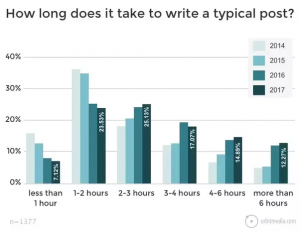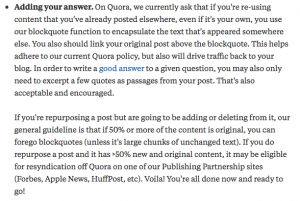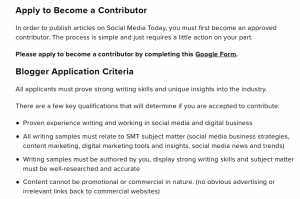Wondering how you can repurpose blog content?
Back in the days, blogging used to be much easier than it is today.
Of course, if you just recently started out blogging, you’re quite fortunate, because you’ve never experienced the huge competitive contrast.
Now, I am generally no person who romanticise the past, but it is safe to say that it was a lot easier gaining traction and succeeding with blogging a few years ago.
But that doesn’t really come as a surprise, does it?
More people than ever are using the internet, and more websites and blogs exist on the web than ever.
In fact, in 2015, more than 2 million blog posts were shared every single day on the web. You can expect that number to be much higher today, and that it won’t be slowing down anytime soon, either.
As a result of the increase in content being shared on the web, the competition in standing out from the crowd, and ranking well on search engines is a true battle, where it comes down to surviving and staying afloat or sinking to the bottom.
Now, if it would stop there, gaining traction would be difficult, sure, but it would absolutely be possible to see great results.
The only catch is, it doesn’t stop there.
In fact, the number of posts being shared on the web isn’t the only thing that has increased.
The length of the posts has also increased over the years.
If you would Google ”ideal length of a blog post” let’s say 10 years ago, the answer would be that you should write a blog post that’s longer than 600 words since the attention span of humans is short, and that they only want to read short blog posts, but today, the blogging landscape looks a whole lot differently.
If you’re blogging and relying on Google traffic, very seldom will you be able to rank well for a 600-word blog post, especially if you’re trying to rank for a competitive keyword.
Today, the average first page results on Google average 1,890 words, according to Orbit.
What’s more, they have also found that blog post length has grown 19% in just one year, up from 1054 words.
I hate to say it, but it’s no surprise, really, when you ask yourself what Google’s goal is.
Google’s goal is to present the most specific, relevant, and thorough piece of content that is a cornerstone post about the topic that the person is searching for.
Do you think 600-word blog posts are just that?
Of course not.
Why would Google present a 600-word post at the top when there are hundreds or even thousands of posts that are far more detailed and specific that provide the searchers more value, which Google can choose from?
While bashing out a 300, 500, or 600-word blog post could be done in less than an hour when short blog posts were all the fuzz, writing a 3000, 8000, or even 17,000-word blog post like this one can take numerous days!
Today, the average blog post takes 3 hours 20 minutes to write. What’s more, while the variations are huge in the amount of time people spend on their posts, the percentage of people who spend 6+ hours on average has more than doubled in the last few years:

How will you possibly have that amount of time as a busy marketer and blogger, especially, if you’re going to be blogging consistently (which you should)?
Give me a break.
The good news is that while it might all of this might seem intimidating, I have a secret recipe to share with you today, that will allow you to bash out fresh and new pieces of content, not only for your blog but everywhere on the web.
Because it’s not only writing a blog post that takes time, it’s creating social media posts, recording your podcast, writing an ebook, and so on.
In other words, creating content in general.
That secret is to repurpose blog content.
Repurposing content, and repurposing blog content specifically, is a huge time-saving tactic that will allow you to crank out more high-quality content by leveraging the content you’ve already created and drive more results by taking advantage of your prior efforts.
It’s safe to say that creating high-quality content is both difficult and time-consuming, but it’s not only the time that’s an issue with always cranking out content.
Have you ever sat yourself down to write a blog post and then 10 minutes find yourself in the very spot not having written a single word because you are out of ideas on what to write about?
Or have you ever gotten ready to create a social media post just to find yourself clueless on what to post?
By repurposing blog content, that won’t be an issue, because you never find yourself starting from scratch.
Instead, you use your existing blog posts as your starting point.
If you want to produce high-quality content, but with less effort and time, and cram out the very last drops from your previous efforts in creating blog posts, continue reading.
In this post, I am sharing 29 ways to Repurpose blog content
29 Kick-ass ways to Repurpose blog content
1. Share your posts (or part of your posts on Reddit)
Reddit is a tremendous platform to showcase your expertise and establish yourself as a go-to-leader in your industry. Maybe most importantly for you, Reddit is a great source of traffic, if you succeed in providing valuable answers that aren’t too promotive.
However, if you’re going to write high-quality answers, it will take a lot of time and effort, so why not just take parts of a blog post that you’ve written that answers the question someone asks, provides them with value, and at the same time allows you to promote yourself?
By doing this successfully, you’ll be able to repurpose blog content by using it to answer people’s question, and of course, get multiple benefits from it at the same time. You can even buy upvotes on reddit, see here: 9 Best Sites to Buy Reddit Upvotes & Downvotes (2020) – Bumped
2.Repurpose blog content by syndicating your blog posts
You’ve spent all this time and energy into writing a blog post, so obviously, you want to cram as much as benefits and marketing juice as you possibly can from it.
One way to do this is by syndicating your blog posts.
What does this mean?
It means that you piggyback off other people’s website by paying money (often PPC) to have your blog post be suggested as a related post on another website or blog pointing back to yours.
The links you receive are normally no-follow, so they won’t grant you any SEO benefits, however, if done correctly, you can drive valuable traffic to your site.
3. Turn your blog posts into ebooks
This one of the most common ways to repurpose blog content since it allows monetization or can be leveraged in other ways, for example, to drive traffic.
Chances are, you’ve written a lot of blog posts that are focused on one specific topic, so why not take all of that content and turn it into an ebook, and then add the parts that are missing to make it complete?
As mentioned, there are a number of ways that you can leverage your ebook once it is done, but the two most common is either to sell it or give it away for free in an effort to collect email addresses.
Now, you might be thinking, ”why in the world would people pay for something that’s already for free?” and there are several answers to that question.
Firstly, there’s a convenience factor.
People love paying for comfort and to save time.
Just think about the fast track lane on airports.
What you do when you sell an ebook is gather all the information in one place, rather than them having to actively look for the next part, and even more, have to try and figure out what they need to learn next, rather than having an expert saying ”this is what you need to learn next”.
The best part is that when you create an ebook, you don’t have to rewrite everything in fear of having duplicate content on your site since you make your ebook into a PDF.
You’d be surprised at how many of the evokes out there started as blog posts.
Now, with ebooks, you don’t necessarily have to write a lot, but what you should do, however, is make your ebook visually appealing. Include photos, sketches, designs, etc, that allow you to better convey your point and let the reader know exactly what you mean.
The best parts that people value ebooks a whole lot more than blog posts because people expect blog posts to be free.
This is why ebooks are such a great value proposition whatever you wish to do.
4.Promote your content on Growth Hackers
If you want to generate some more marketing results from your old and existing blog posts, Growth Hackers is a great way to squeeze out some extra marketing benefits.
What it does is allow you to promote your content (related to marketing for startups). Just submit your URL and enjoy the increased exposure.
Note, however, that if you don’t have content related to startup marketing, this site isn’t for you.
5.Share blog posts on Twitter
The most common way that people promote their blog posts on Twitter is sharing the link to the post and that’s it.
But unfortunately, this isn’t the best way to drive for eyeballs to your old blog posts.
Instead, what you want to do is take a part of your blog post and use that as a caption, and then include your link.

Doing this will get your audience to start reading, and then become engaged and enticed to read the full story, and thus click through on your link.
The part you take form your post should obviously be the most engaging and interesting part, but it is also fine to take a quote from that article and use it as your Twitter caption.
6.Repurpose blog content by turning them into webinars
People love webinars.
What’s more, webinars are incredible marketing tools that have tremendous marketing and conversion power.
Webinars can be used for a number of different reasons, but since using videos on landing pages can increase conversions by 86% (Source), the brands that have realized this often use them on their landing pages.
For example Neil Patel with Quicksprout:

When turning your blog posts into webinars, you can use the blog post as the foundation for your webinar. In fact, you can even use your blog post as your script for the webinar. You can present your webinar live with Google Hangouts, and then record it to make it possible for people to buy it over and over again.
Webinars open up a whole array of opportunities for you and your brand.
You can use it to collect emails, to showcase your expertise, and ultimately to get your audience to convert.
Now, webinars are quite similar to presentations, but not identical.
When you upload your presentations to the web, you upload multiple slides after each other that contain key information, but when you upload a webinar, you upload a video where you go through each slide in the presentation and talk about the key points.
With webinars, what’s normally recorded is the slides, so don’t worry if you’re camera shy.
The great thing about creating a webinar is that you can repurpose a whole lot from your previously created content.
You’ve already written blog posts, so there you have the foundation for your webinar. Then, if you’ve created a presentation where you have presented key points, facts, and statistics from a post, that’s even better. Now, all you have to do is use the blog post you used as the foundation for the presentation, as a script, and then record the presentation while you’re talking about each point.
7. Share your blog posts on Hacker News
If you aren’t familiar with Hacker news, it is, according to Wikipedia’s definition ”a social news website focusing on computer science and entrepreneurship. It is run by Paul Graham’s investment fund and startup incubator, Y Combinator. In general, content that can be submitted is defined as “anything that gratifies one’s intellectual curiosity”.
It works similar to Reddit, only that it is focused on computer science and entrepreneurship rather than topics about everything and anything, like Reddit.
So if your blog posts are focused on entrepreneurship or computer science, use parts of your blog posts similarly to Reddit, and use them to answer people’s questions to get more eyeballs on you and your brand, and to drive more traffic back to your blog posts and website.
8. Publish blog posts to Medium
If you aren’t using Medium, you’re missing out on an opportunity of immense exposure.
What medium does is it allows you to republish your existing blog posts in order to get them in front of a new and larger audience.
What’s so amazing about Medium is that you don’t have to write a single new word or a completely new blog post.
All you need to do is copy and paste your blog post to medium and then publish it.
Simple as that.

You can set up an account for free and start publishing content today.
Using Medium is a great idea if you’re investing all this time into writing a kick-ass blog post, just to find that only 5 or 105 people have read it. With Medium, you’ll be able to drive more marketing benefits from your already invested time and energy into writing the blog posts.
Awesome, right?
9.Repurpose blog content to Quora
Quora is a questions and answers platform where people are discussing, asking, and answering virtually any topic you can think of.
This is why chances are, there will be people who are interested in your industry and niche who are on the platform, and who are asking questions that you have the expertise of answering.
Just go to Quora.com and search for your industry, and you’ll (most likely) be able to find questions asked related to it.

The best part is that since answering from scratch takes time, at least if you want to give a thorough and helpful answer that ranks well and gets a lot of exposure, you can leverage your blog posts where you’ve already answered that question.
Simple copy and paste parts of a blog post that answers the question being asked.
Doing this will allow you to use your blog posts to bring people value, and, similar to Reddit and other sites, establish yourself as an industry expert, while at the same time increasing awareness and driving traffic back to your site.
When copying parts of your blog posts and pasting them into your Quora answers, be very careful, and make sure you’ve read Quora’s policies first.
If you don’t do it properly and don’t state the source from which you took the text (your own blog), they might delete your answer, or even eventually ban your account.
This is what Quora says:

10.Repurpose blog content by making them a LinkedIn post
LinkedIn is great because it allows you to share your blog posts with a larger audience without worrying about having your post deleted etc.
But when using LinkedIn, you shouldn’t just copy and paste your complete post, though. Instead, ideally, you should showcase a short sniper of the text in your blog post and then include the link to your post.
Doing this will make people start reading, and then, since they’ve already begun reading, they’ll be enticed in continuing to read the full post, and so they click through to it and visit your site to read it all.
Repurposing blog content for LinkedIn does not only give you something to share with your audience on LinkedIn, but it also helps you drive more traffic to your site.
11. Turn your blog posts into infographics
Infographics are tremendous marketing tools.
And that doesn’t come as a surprise when you think about the fact that humans are visual creatures.
Just look at these statistics about the human brand and visual content compared to text:

As you can see, 40% of people respond better to visuals, but the truth is also that visual content alone isn’t enough.

What you need to do is mix text and visual content to best convey your message, and the best way to do that is by creating appealing and delicious infographics.
Simply take the information in a blog post, and insert that information into an infographic format.
There are plenty of free template tools you can use to create your infographics, but the one that I’ve found most smooth and easy to use is Canva.
Making infographics from your blog posts will give you completely new pieces of content that your audience likes, and that is far more shareable than pure text.
In fact, Infographics can increase web traffic by 12%.
What’s more, creating infographics will also give you powerful social media content as well, since Infographics are liked and shared on social media 3x more than other any other type of content.
Of course, infographics are best made from blog posts that are more data-driven, but you can also create infographics that are less data-driven by including key points.
12.Publish your blog post to Business 2 Community
Business to community, sometimes referred to as B2C, is a site focusing on the following topics:
- Digital & Social
- Sales & Marketing
- Business & Finance
- Life & Entertainment
- Technology & Innovation
- US & World News
- BrandViews
By taking your posts and publishing there, you’ll be able to get more bang for your time, and so be able to drive more results from your efforts.
13.Repurpose blog content to Google+
Google+ has always struggled in the social media landscape and has never really established itself as a social media platform to count on, however, sharing content there and leveraging the platform in the right way can drive you tons of exposure.
Take your already shared blog posts and then share them to Google+
Doing so will allow you to attract more people back to your site as a result of your high-quality content.
14. Pinterest
Pinterest is a great place to repurpose your blog content if it has appealing visual content.
Pinterest is a visually driven social media platform, which means that you need to have powerful visual content to succeed on the platform.
And so, if you’re good at creating visuals, you can create a new piece of visual content that you can post to Pinterest in order to repurpose your blog post and drive it more traffic and exposure.
15. Repurpose blog content by sending your best pieces in an email newsletter
Now, the marketing landscape may have evolved immensely over the years, but email marketing still proves to be effective.
In fact, 59% of B2B marketers say email is their most effective channel in terms of revenue generation.
But how do you create an appealing email that people take the time to actually read?

Or even further, how do you find the time creating all the content that is supposed to go into your email newsletter?
Well, you’ve got all your blog posts, why not repurpose them and include them or parts of them into your email newsletter?
Think about it, chances are, you spend far more time writing a blog post than writing text in an email, so why not instead include your high.quality pieces of blog posts in your email instead?
16.Repurpose blog content into a presentation
Your blog posts probably have a lot of delicious statistics, quotes, advice, etc.
If you want to create new pieces of content, why not repurpose your blog posts into a presentation with slides that contain key information that has been extracted from your blog post?
Repurposing blog content into presentations means you don’t have to create any new content, but rather see what fits where, when taking the information that was in your blog post.
Creating the slides is made easy with free photo-editing programs like Canva. One helpful feature of Canva is the premade templates for things like social media images, blog graphics, and presentation slides.
Once the slides are created, you can create the presentation or slide deck using a tool like PowerPoint, Prezi, or Google Drive.
17.Create an expert roundup
Creating high-quality blog posts is hard. That’s no secret.
But what if you could create them, without having to write many words yourself, but instead, have other people write them for you?
And do this for free!
Count me in!
Expert roundups mean that you’re reaching out to ”experts” in your industry and ask them to answer with their views on a question, topic.
When doing this, you can take the topic and questions of one of your old articles, and then ask the experts to give their view on it. When asking, just ask for a short snippet of text, though, because if you’re asking for a full-on blog post from them, many people will say no or not answer due to lack of time.
When the experts have answered your question, you can create a new blog post with all of the answers, and then link back to your old post from the new one.
People love expert roundups since it allows them to get the opinions and viewpoints from experts that they trust.
18.Repurpose blog content into a podcast
If you have blog posts and want to create new pieces of content for your audience, but just lack ideas, and don’t want to start researching completely new topics to create content about, podcasting is the answer.
With podcasting, you can use your existing blog posts as the script, and either just read directly from it, or, you can use the blog posts as an outline for the things you’re going to talk about in your podcast episode.
Podcasts are a great form of content because it welcomes a completely new audience of people who either don’t like to read, or don’t have the time to read.
What’s so good about podcasts is that they allow you to be passive, and do something at the same time as you’re listening. When you’re reading a blog post, you need to be fully immersed in it.
So by repurposing blog content into podcasts, you can attract a completely new audience, and thus grow your following since you’re now creating content that caters to a larger audience.
You’ve already created the script, now, it’s time to start recording yourself.
19.Update and improve your existing posts
Who says you have to start from scratch with content?
Chances are, you’ve written a bunch of posts that just didn’t get the traction you were hoping for, and since posting, you’ve just let them sit there and collect dust.
While these didn’t gain traction the first time, they might gain more traction the second try. Or, they might just need some polishing in order to become better and more appealing.
Before you post it again and present it as a completely new piece of content, make sure you update it so it is up-to-date, and contains new, fresh information making your post even more valuable.
Often times, when you look back at old pieces of content, you notice that there are some factualities that are out of date, that you’ve not covered everything there is to cover about a certain topic, etc.
The thing is, it takes a lot more effort and time to create a new blog post from scratch rather than just updating and building on top of an already existing blog post.
Rather than creating a completely new blog post about a topic you’ve already written about, it is a lot better to continue building on one that already exists as you’ll save both time and energy, plus, risk duplicate content or being repetitive.
20. Turn your blog posts into videos
This point of repurposing blog content is quite similar to turning your blog posts into podcasts. The only difference is that you record a video instead of recording voice.
There are obviously a number of ways to do this, however, the format doesn’t have to be a lot different from the way you repurpose blog content into a podcast.
Simply set up a camera and start recording yourself talking, using existing blog posts as the script, or an outline of the video,
It’s safe to say that far from everyone are people who have reading as their preferred way of consuming content.
What’s more, it’s not only that, but other types of content, with video, in particular, has proven that it is able to mediate the message a lot better than text, and therefore impact the people who are consuming it.
And the truth is, that’s not very strange if you consider the fact that humans are visual creatures.
After all, our brain processes visual content 60,000 faster than text. Plus, a picture says more than a thousand words, so how about a video that is recorded in 60 photos (frames) per second.
I think you get the point.
What’s more, video also includes sound, which means several senses are activated at once.
With the drastic increase in other types of content than text, many people are moving away from reading, for several reasons.
And that leaves me sitting here and writing with no-one reading….
Except for you, but that’s an incentive enough for me!
Just like podcasting, you’ll be able to cater to a larger audience with video, and since you’ve already written the foundation for many videos to come, now it’s just up to you to start recording.
21.Repurpose blog content into a physical book
Now, this is a more hardcore way of repurposing blog content, but hey, if you’ve already created tons of blog posts, why not make them, or parts of them into a book?
The principle is very similar, if not identical to repurpose blog content into an ebook.
Outline the book and then pick the best parts (or all parts) of your existing blog content, add text where needed, and voila!
Physical books are normally a lot longer and thorough than just blog posts or ebooks which means that they can have a greater macro impact, and drive your brand and yourself much greater exposure.
22.Repurpose a summary of individual posts
What does this mean?
Well, if you’ve created a numbered list post, you have a real gold mine for blog content repurposing.
People live numbered list posts, and they do this because they’re much more specific, clear, and digestible than other posts that aren’t as clearly structured.
Since list posts are so common, chances are, you’ve created some yourself.
The good news is that these are perfect for dissecting that post, and taking each individual point, and turning each of them into their very own post.
Now, doing this still means some work since you have to write, but the good news is that you’ve already scratched on the surface for that topic, so you probably know somewhat well how you’re going approach writing about that topic.
What’s more, a frustrating part of blogging is sitting at your computer ready to write, but not coming up with a single idea and topic to write about. With this tactic, that won’t be an issue.
23. Use your existing blog posts to write a guest post
Now, generally, aren’t allowed, to contribute with a guest post to another site by taking an existing post of yours and submitting it.
However, what you can do is take the key points of a previous article of yours and then use the same outlining and inspiration for the guest post, just write it in a different way, and include some new fresh statuses etc.
Some sites will allow you to submit posts that you’ve already written and posted to your site, and that’s obviously great for you because it means that you don’t have to spend time and energy writing, but can instead repurpose blog content that you’ve already created.
24.Publish to Social Media Today
Social media Today is a site that allows you to apply to become a writer through a form, and then, the editors of the site choose the best content to be featured on their site.
Now, this means that you need to create super thorough, kick-ass content, but I have no doubts that you already do, so what’s missing is that you submit your blog posts and hope for the best.

24. Blokube
Bloke is a great place to be active on if your content is dedicated to other bloggers.
Bloke describes itself as ”Designed to help you share and engage, Blokube is a site built by bloggers for bloggers.
We understand that regardless of niche and your market, the most important aspect of blogging lies in the power of community, and that’s why, here at Blokube, we’ve gone out of our way to make sharing, engaging and interacting online easier than ever before.”
If you want more exposure to your existing blog posts, and want to share content on the platform, take advantage of your existing posts, and leverage them, similarly to how you do it on Reddit, Quora, etc.
25. ZergNet
”ZergNet is the leading editorial recommendations platform on the Internet. We’re committed to protecting the integrity of the publishing ecosystem by delivering only the highest quality content recommendations and providing 100% pure editorial content.”
In other words, it is a site where you can promote your content.
The best part is that you’ve already written your blog content. Now, it’s time to start promoting it.
25.Repurpose blog content into a downloadable PDF
Now, this is almost identical to crafting an ebook., but the only difference is that you don’t even have to combine blog posts and add more text to it to make it more thorough.
Simply take your existing blog posts and turn them into downloadable PDFs.
Similar to changing formats of your blog posts, doing this will allow you to cater to a larger audience.
26. Repurpose blog content into Facebook posts
Facebook is a great place to promote your blog content.
What’s even better is that there are plenty of groups on Facebook dedicated to specific topics and niches, and you can be sure that there are groups related to your very own industry where you can share your content.
If you’re joining a group on Facebook, don’t just start promoting your content, though.
When inside a Facebook group, you also need to contribute to the community by responding to people’s questions, sharing your thoughts, and engaging with other people’s content.
But groups, where the members are engaged, is the perfect place to repurpose your blog posts and turn them into Facebook posts to drive more traffic back to your site.
27.Repurpose blog content by sharing snippets on social media
Now, I’ve talked about specific social media platforms when mentioning this approach of repurposing content, however, this is something that has proven to be effective for all social media platforms.
Simply copy and paste a snippet of the blog post you want to share with your audience on social media, and then include the link to that post.
Rather than having to write a caption for your social media post, you already have the post ready inside of your blog post, which means you’ll save time with this approach.
Moreover, since people have already started reading your blog post, they’ll be eager to continue reading and finding out more, and therefore click the link to the blog post.
28.Livestream
Live streaming has increased in popularity in just a few years, and an important reason for that is that live streaming allows for in-the-moment interactions between the person broadcasting, and the people watching.

With live streaming, people can interact with the broadcaster and get responses in real-time. And maybe most importantly, live streaming makes the conversation so much more authentic and genuine, and as a result, the people who are watching will be able to resonate with the person/brand broadcasting much better.
But what should you live stream about?
Live streaming can be a bit scary, because you’re broadcasting live, and you don’t want to forget what you’re going to say and just stand there.
But don’t worry.
Just like when you record a podcast or a video, your blog content is a great resource.
Simply use a blog post as an outline for your live stream presentation/chat, and make that particular live stream about that topic.
29.Create an online course
An online course is generally very similar to an ebook, which I talked about earlier, but when repurposing an online course, you want to also include further resources, such as templates, etc, and make the steps very clear to follow, from start to beginning, but most of this probably already exist in your blog posts, so you just got to compile them and create a seamless online course out of the content.
The process to repurpose blog content
The process to repurpose content is actually super simple.
Of course, the way you repurpose obviously differs depending on how you’re going to use your piece of content, but the foundation remains the same.
Step 1:
Firstly, you obviously need to create your piece of content. This is what takes the most time, and so, once you’ve already got your content sorted, that’s when you can start repurposing to still be able to push out fresh new content.
However, in order to be able to repurpose blog content, you obviously need to create it first, and thus, creating it is the fundamental step.
Have in mind though, that the content you produce needs to be evergreen. Evergreen content is the type of content that isn’t time-bound for example about a new update, or an event. The reason is that if you do, that content will quite quickly become irrelevant and outdated, and repurposing often happens several months or even years after the initial piece of content has been created, which means if you’re going to repurpose a blog post that is very time-bound, by the time you re going to repurpose it, it will be outdated and irrelevant.
Evergreen content is content that withstands time, and remains relevant year after year, and might only need a few changes and tweaks over time to still remain relevant.
Step 2:
Identify the most popular blog posts you’ve created.
Step 3:
Decide in which way you want to repurpose your blog post. You can choose from one of the 29 listed ways to repurpose blog content in this blog post, or if you can come up with another way that you think is better, go ahead and use that.
Step 4:
Start repurposing your content, tweaking it, updating it, or taking the parts you want to use.
Step 5:
Share your new repurposed piece of content with the world!
Conclusion
As you can see, there are a ton of ways you can repurpose blog content. Unfortunately though, the vast majority of people never repurpose any of their blog content They may spend countless of hours writing their blog posts, but simply publishing to the web means just taking advantage of a small portion of the blog contents’ potential, and definitely not getting the most out of the invested efforts.
By repurposing blog content, you make sure that you get the most out of your blog content and the time you’ve invested writing it.


